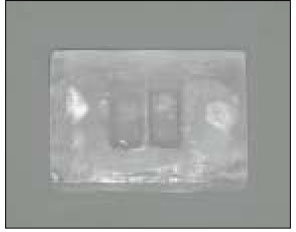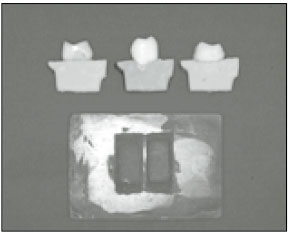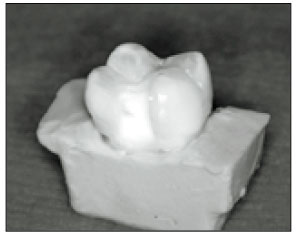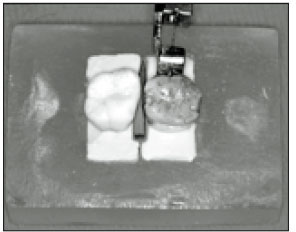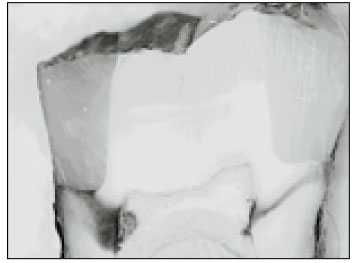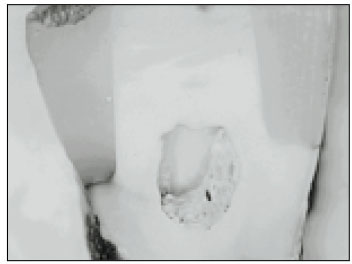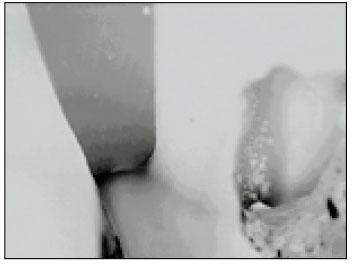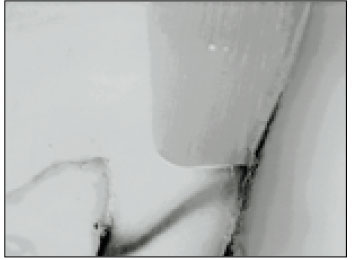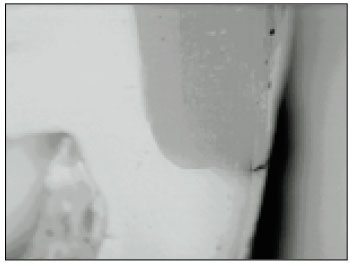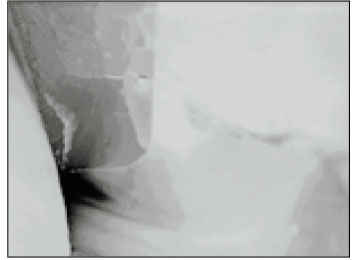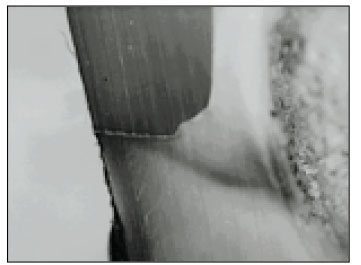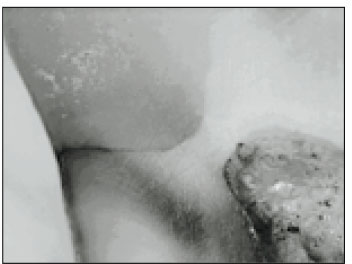J Korean Acad Conserv Dent.
2002 Sep;27(5):502-514. 10.5395/JKACD.2002.27.5.502.
The effect of sandwich technique using flowable composite resin base on the microleakagein class II cavities of molar
- Affiliations
-
- 1Department of Conservative Dentistry, Collage of Dentistry, Dankook University, Korea.
- KMID: 1987307
- DOI: http://doi.org/10.5395/JKACD.2002.27.5.502
Abstract
- The aim of this study was to evaluate the marginal adaptation of direct class II sandwich restoration with packable composites(P-60), resin modified glass ionomer cement(Fuji-II LC), flowable compomer(Dyract Flow), flowable composites(Filtek Flow) in comparison with total bond restorations. In addition, for sandwich restorations, influence of different sandwich techniques was also evaluated. Large butt-joint box typed class II cavites with cervical margins 1mm below the cemento-enamel junction were cut into 70 extracted human molars. The cavities(7 groups, n=10) were filled using a closed/open sandwich restoration or total bond restoration technique with materials according to the manufacturer's recommandation using the single-component bonding agent for each system. Teeth were thermocycled 500 times between 5degrees C and 55degrees C with 30-second dwell time. The teeth were then coated with nail polish 1mm short of the restoration, placed in a 2% methylene blue for 24 hours, and sectioned with diamond wheel. Sections were examined with a stereoscope to determine the extent of microleakage. Dentine/Cementum margins were analyzed for microleakage on scale of 0(no leakage) to 4(entire axial wall) and interface between materials, on scale of 0(no leakage) to 3(axial wall). Results were evaluated with Kruskal Wallis Test, corrected for ties, to determine whether there were statistically significant differences among the seven groups. Pairs of groups were analyzed using the Student-Newman-Keuls Method and Dunn s Method. The results were as follows: 1. All groups showed some micoleakage in cervical portion. But there were no microleakage in interface between materials. 2. Closed sandwich restorations with Fuji-II LC and Filtek Flow had significantly lower leakage rating than total restorations with only P-60. However, open sandwich restorations with Dyract Flow showed significantly higher (P<0.05). 3. Closed sandwich restorations had significantly lower leakage rating than total restorations. However open sandwich restoration s showed significantly higher (P<0.05). 4. Sandwich restorations with Fuji-II LC were lower leakage than only P-60, Filtek Flow, Dyract Flow. But there were no statistically differences among the materials. From the results above, it could be concluded, closed sandwich restorations was effective in reducing microleakage of class II restorations. The best results showing the least microleakage were for the closed sandwich technique with Fuji-II LC and Filtek Flow.
MeSH Terms
Figure
Reference
-
1. Cirm GA, Kenneth WC. Reducing microleakage in class II restorations: An in vitro study. Quintessence Int. 1994. 25:781–785.2. Opdam NJ, Roeters JJ, Burgersdijk RC. Microleakage of class II box-type composite restoration. Am J Dent. 1998. 11(4):160–164.3. Borgmeier PJ, Kreulen CM, van Amerongen WE, Akerboom HB, Gruythuysen RJ. The prevalence of postoperative sensitivity in teeth restored with Class II composite resin restorations. ASDC J Dent Child. 1991. 9-10. 58:378–383.4. Leinfelder KF, Bayne SC, Swift EJ Jr. Packable Composites: Overview and technical considerations. J Esthet Dent. 1999. 11:234–249.
Article5. Opdam NJ, Roeters FJ, Feilzer AJ, Verdonschot EH. Marginal integrity and postoperative sensitivity in Class II resin composite restorations in vivo. J Dent. 1998. 26(7):555–562.
Article6. Manhart J, Chen HY, Hickel R. The suitability of Packable resin-based composites for posterior restoration. J Am Dent Assoc. 2001. 132:639–645.
Article7. Tung FF, Estafan D, Scherer W. Microleakage of condensible resin composites: An in Vitro Investigation. Quintessence Int. 2000. 31:430–434.8. Leinfelder KF, Radz GM, Nash RW. A report on a new condensable composite resin. Compend Contin Educ Dent. 1998. 19:230–237.9. Leinfelder KF. New development in resin restorative system. J Am Dent Assoc. 1997. 128(5):573–581.10. Crim GA, Chapman KW. Reducing Microleakage in Class II restoration: An in vitro study. Quintessence Int. 1994. 25:781–785.11. Darbyshire PA, Messer Lb, Douglas WH. Microleakage in Class II composite restorations bonded to dentin using thermal and load cycling. J Dent Res. 1988. 67(3):585–587.
Article12. Prati C, Tao L, Simpsont M, Pashley DH. Permeability and microleakage of class II resin composite restoration. J Dent. 1994. 22(1):49–56.13. Tjan AH, Bergh BH, Lidner C. Effect of various incremental techniques on the marginal adaptation of class II composite resin restoration. J Prosthet Dent. 1992. 67:62–66.
Article14. Unterbrink GL, Muessner R. Influence of light intensity on two restorative system. J Dent. 1995. 23(3):183–189.15. De Goes MF, Rubbi E, Baffa O, Panzeri H. Optical transmittance of curing reflecting wedges. Am J Dent. 1992. 5(2):78–80.16. Hirschfeld Z, Frenkel A. Marginal leakage of class II glass ionomer-composite resin restorations: An in vitro study. J Prosthet Dent. 1992. 67:148–153.
Article17. Dietrich TH, Losche AC, Losche GM. Marginal adaptation of direct composite and sandwich restorations in class II with cervical margins in dentine. J Dent. 1999. 27:119–128.
Article18. Rodrigues JA. In vitro microleakage of glass ionomer composite resin hybrid materials. Oper Dent. 1999. 24:89–95.19. Hotta M, Aono M. Adaptation to the cavity floor of the light-cured glass ionomer cement base under a composite restoration. J Oral Rehabil. 1994. 21:679–685.
Article20. Aboushala A, Kugel G, Hurley E. Class II composite resin restorations using glass ionomer liners: microleakage studies. J Clin Pediatr Dent. 1996. 21:67–71.21. Leevailoj C, Cochran MA, Matis BA, Moore BK, Platt JA. Microleakage of posterior packable resin composites with and without flowable liners. Oper Dent. 2001. 26:302–307.22. Estafan AM, Estsfan D. Microleakage study of flowable composite resin systems. Compend Contin Educ Dent. 2000. 21(9):705–708. 710712quiz 714.23. Estafan AM, Estsfan D. Microleakage study of flowable composite resin systems. Compend Contin Educ Dent. 2000. 21(9):705–708. 710712quiz 714.24. Shortall A, Asmussen E. Influence of dentin-bonding agents and a glass ionomer the cervical marginal seal of class II composite restorations. Scand J Dent Res. 1988. 26:590–594.25. Dietschi D, De Siebenthal G, Neveu-Rosenstand L. Influence of restorative technique and new adhesives on the dentin marginal seal adaptation of resin composite class II restorations: An In vitro evaluation. Quintessence Int. 1995. 26:717–727.26. Lim CC, Neo J, Yap A. The influence of finishing time on the marginal seal of a resin-modified glass ionomer and polyacid-modified resin composite. J Oral Rehabil. 1999. 26:48–52.
Article27. Meyer JM, Cattani-Lrente MA, Dupuis V. Compomer: Between glass ionomer cements and composite resins. Biomaterials. 1988. 19:529–539.
Article28. Hinoura K, Moore BK, Phillips RW. Tensile bond strength between glass ionomer cements and composite resins. J Am Dent Assoc. 1987. 114:167–172.
Article29. Li J, Liu Y, Liu Y, Söremark R, Sundström F. Flexure strength of resin-modified glass ionomer cements and their bond strength to dental composites. Acta Odontol Scand. 1996. 54:55–58.
Article30. Mangum FL, Ebb AB, Udayan K, Parikh BS, David L. Optima etchaing time of glass ionomer cemnet for maximum bond of composite resin. J Am Dent Assoc. 1990. 120:535–538.
Article31. Causton B, Sefton J, Williams A. Bonding class II composite to etched glass ionomer cement. Br Dent J. 1987. 163:321–326.
Article32. Knibbs PJ. Glass ionomer cement: 10 years of clinical use. J Oral Rehabil. 1988. 103–115.
Article33. Reid JS, Saunders WP. An in-vitro investigation of microleakage and gap size of glass ionomer/composite resin "sandwich" restoration in primary teeth. ASDC J Dent Child. 1994. 7-8:255–258.34. Mount GJ, Hume WR. BD Kno . Preservation and Restoration of Tooth.35. Feilzer AJ, De Gee AJ, Davidson CL. Relaxation of polymerization contraction shear stress by hydroscopic expansion. J Dent Res. 1990. 69(1):36–39.
Article36. Aarnts MP, Akimade A, Feilzer AJ. Effect of filler load on contraction stress and volumetric shrinkage. J Dent Res. 1999. 78:3014.
- Full Text Links
- Actions
-
Cited
- CITED
-
- Close
- Share
- Similar articles
-
- Survival Rates of Class II Restoration in Primary Molar with Flowable Resin Composite
- The effect of marginal microleakge according to thickness of flowable resin
- Microleakage of posterior packable composite resin at the gingival margins of class II cavities
- Comparison of microleakage after load cycling for nanofilled composite resin fillings with or without flowable resin lining
- Influence of flowable composite lining on microleakage at the gingival dentin margin

